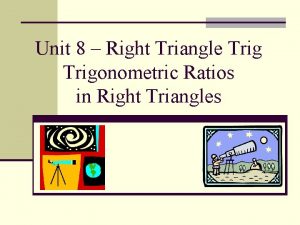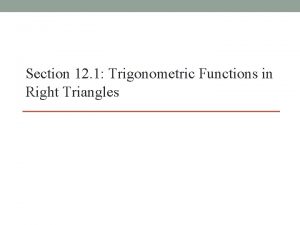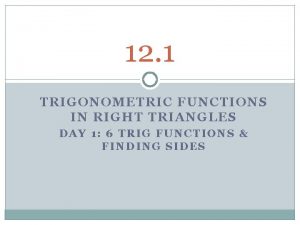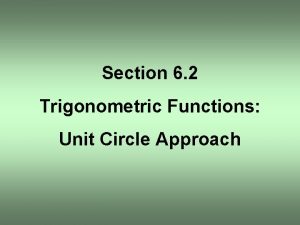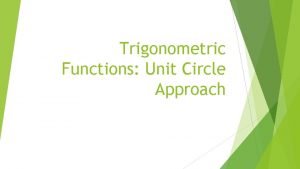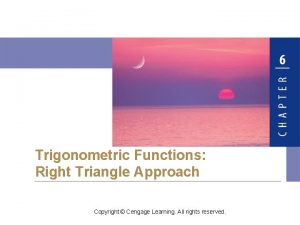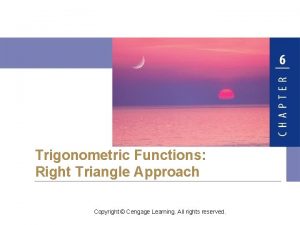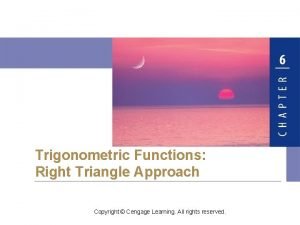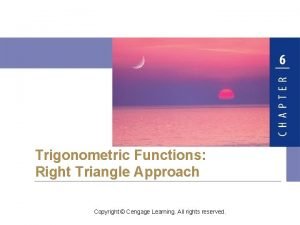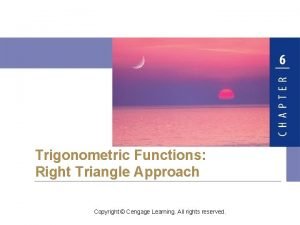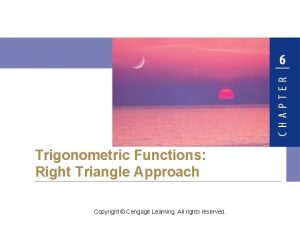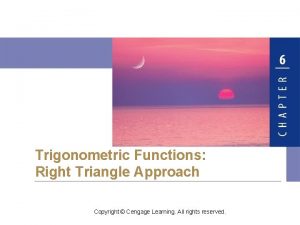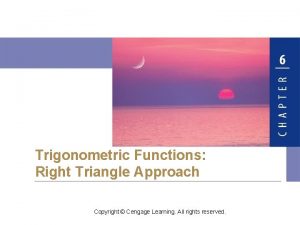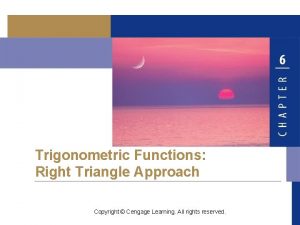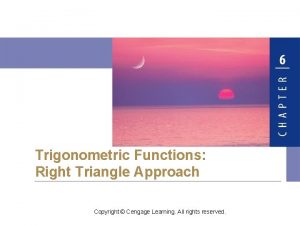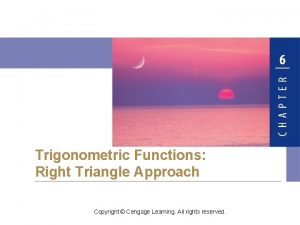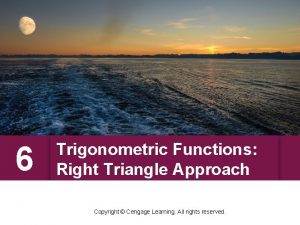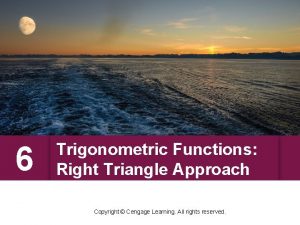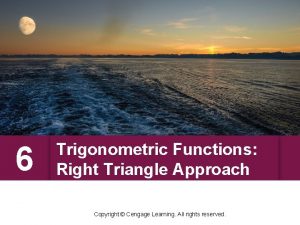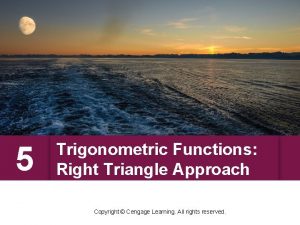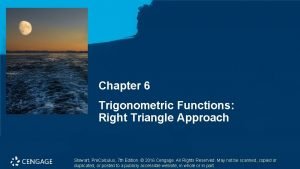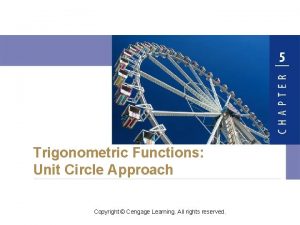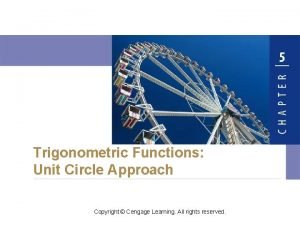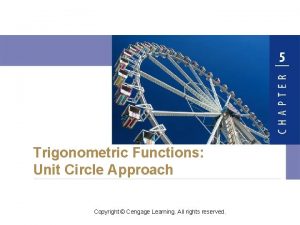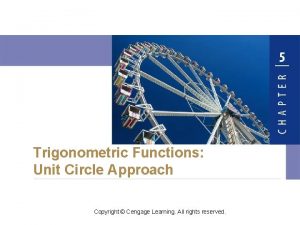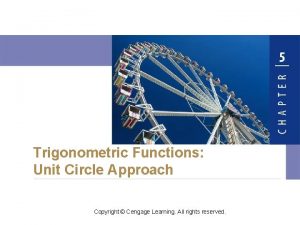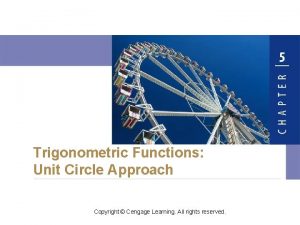Trigonometric Functions Right Triangle Approach Copyright Cengage Learning
























- Slides: 24

Trigonometric Functions: Right Triangle Approach Copyright © Cengage Learning. All rights reserved.

6. 6 The Law of Cosines Copyright © Cengage Learning. All rights reserved.

Objectives ■ The Law of Cosines ■ Navigation: Heading and Bearing ■ The Area of a Triangle 3

The Law of Cosines The Law of Sines cannot be used directly to solve triangles if we know two sides and the angle between them or if we know all three sides. In these two cases the Law of Cosines applies. 4

Example 2 – SSS, the Law of Cosines The sides of a triangle are a = 5, b = 8, and c = 12 (see Figure 4). Find the angles of the triangle. Figure 4 5

Example 2 – Solution 6

Example 2 – Solution cont’d Using a calculator, and the law of sines, we find that B = 29 and A = 180 – (133 +290) = 18 Of course, once two angles have been calculated, the third can more easily be found from the fact that the sum of the angles of a triangle is 180. 7

Navigation: Heading and Bearing 8

Navigation: Heading and Bearing In navigation a direction is often given as a bearing, that is, as an acute angle measured from due north or due south. The bearing N 30 E, for example, indicates a direction that points 30 to the east of due north (see Figure 6). Figure 6 9

Example 4 – Navigation A pilot sets out from an airport and heads in the direction N 20 E, flying at 200 mi/h. After one hour, he makes a course correction and heads in the direction N 40 E. Half an hour after that, engine trouble forces him to make an emergency landing. (a) Find the distance between the airport and his final landing point. (b) Find the bearing from the airport to his final landing point. 10

Example 4 – Solution (a) In one hour the plane travels 200 mi, and in half an hour it travels 100 mi, so we can plot the pilot’s course as in Figure 7 11

Example 4 – Solution cont’d So the angle between the two legs of his trip is 160. So by the Law of Cosines we have b 2 = 2002 + 1002 – 2 200 100 cos 160° 87, 587. 70 Thus, b 295. 95 and the pilot lands about 296 mi from his starting point. 12

Example 4 – Solution cont’d (b) Find the bearing from the airport to his final landing point. We first use the Law of Sines to find A. 13

Example 4 – Solution cont’d We find that A 6. 636. From Figure 7 we see that the line from the airport to the final landing site points in the direction 20 + 6. 636 = 26. 636 east of due north. Thus, the bearing is about N 26. 6 E. Figure 7 14

The Area of a Triangle 15

Areas of Triangles The area of a triangle is base height. If we know two sides and the included angle of a triangle, then we can find the height using the trigonometric functions, and from this we can find the area. If is an acute angle, then the height of the triangle in Figure 16(a) is given by h = b sin . Thus the area is base height = sin (a) Figure 16 16

Areas of Triangles If the angle is not acute, then from Figure 16(b) we see that the height of the triangle is h = b sin(180° – ) = b sin (b) Figure 16 17

Areas of Triangles This is so because the reference angle of is the angle 180 – . Thus, in this case also, the area of the triangle is base height = sin 18

Example 8 – Finding the Area of a Triangle Find the area of triangle ABC shown in Figure 17 Solution: The triangle has sides of length 10 cm and 3 cm, with included angle 120. 19

Example 8 – Solution Therefore sin (3) sin 120 = 15 sin 60 Reference angle 13 cm 2 20

The Area of a Triangle An interesting application of the Law of Cosines involves a formula for finding the area of a triangle from the lengths of its three sides (see Figure 8). Figure 8 21

The Area of a Triangle 22

Example 5 – Area of a Lot A businessman wishes to buy a triangular lot in a busy downtown location (see Figure 9). The lot frontages on the three adjacent streets are 125, 280, and 315 ft. Find the area of the lot. Figure 9 23

Example 5 – Solution The semiperimeter of the lot is By Heron’s Formula the area is Thus, the area is approximately 17, 452 ft 2. 24
 Cho sha cao
Cho sha cao Copyright cengage learning. powered by cognero
Copyright cengage learning. powered by cognero Right product right place right time right price
Right product right place right time right price Family time
Family time Tony wagner's seven survival skills
Tony wagner's seven survival skills 12-1 trigonometric functions in right triangles
12-1 trigonometric functions in right triangles 12-1 trigonometric functions in right triangles
12-1 trigonometric functions in right triangles Trigonometric functions unit circle approach
Trigonometric functions unit circle approach Trigonometric functions unit circle approach
Trigonometric functions unit circle approach The right man on the right place at the right time
The right man on the right place at the right time Delmar cengage learning medical terminology
Delmar cengage learning medical terminology Chapter 5 learning exercises medical terminology
Chapter 5 learning exercises medical terminology Cengage learning heart diagram
Cengage learning heart diagram South-western cengage learning
South-western cengage learning Chapter 13 medical math assignment sheet
Chapter 13 medical math assignment sheet 2009 delmar cengage learning
2009 delmar cengage learning Cengage learning heart diagram
Cengage learning heart diagram Clinical conditions chapter 1 medical terminology
Clinical conditions chapter 1 medical terminology Cengage learning australia
Cengage learning australia Measuring and recording apical pulse
Measuring and recording apical pulse Whille
Whille Cengage learning
Cengage learning Wadsworth cengage learning
Wadsworth cengage learning Cengage learning
Cengage learning Cengage learning plant cell
Cengage learning plant cell
